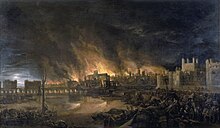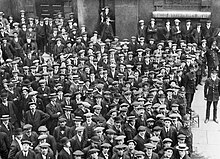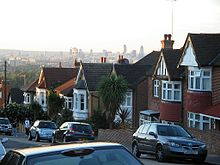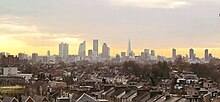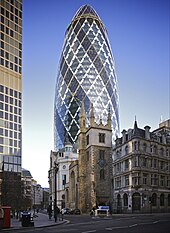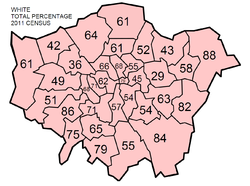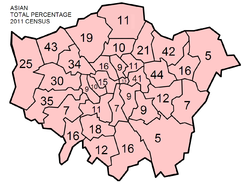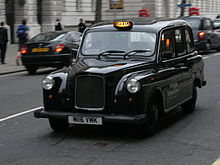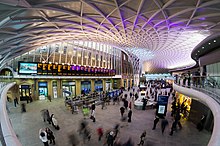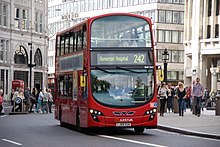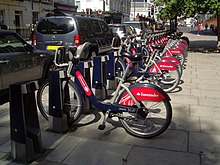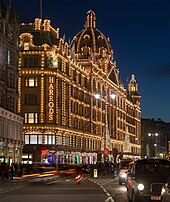london
- London i/ˈlʌndən/ is the capital and most populous city of England and the United Kingdom.[7][8] Standing on the River Thames in the south east of the island of Great Britain, London has been a major settlement for two millennia. It was founded by the Romans, who named it Londinium.[9] London's ancient core, the City of London, largely retains its 1.12-square-mile (2.9 km2) medieval boundaries. Since at least the 19th century, "London" has also referred to the metropolis around this core, historically split between Middlesex, Essex, Surrey, Kent, and Hertfordshire,[10][11][12] which today largely makes up Greater London,[13][14][note 1] governed by the Mayor of London and the London Assembly.[15][note 2][16]
London is a leading global city[17][18] in the arts, commerce, education, entertainment, fashion, finance, healthcare, media, professional services, research and development, tourism, and transportation.[19][20][21] It is crowned as the world's largest financial centre[22][23][24][25] and has the fifth- or sixth-largest metropolitan area GDP in the world.[note 3][26][27] London is a world cultural capital.[28][29][30] It is the world's most-visited city as measured by international arrivals[31] and has the world's largest city airport system measured by passenger traffic.[32] London is the world's leading investment destination,[33][34][35] hosting more international retailers[36][37] and ultra high-net-worth individuals[38][39] than any other city. London's universities form the largest concentration of higher education institutes in Europe.[40] In 2012, London became the first city to have hosted the modern Summer Olympic Games three times.[41]
London has a diverse range of people and cultures, and more than 300 languages are spoken in the region.[42] Its estimated mid-2015 municipal population (corresponding to Greater London) was 8,673,713,[2] the largest of any city in the European Union,[43] and accounting for 12.5% of the UK population.[44] London's urban area is the second most populous in the EU, after Paris, with 9,787,426 inhabitants at the 2011 census.[45] The city's metropolitan area is the most populous in the EU with 13,879,757 inhabitants,[note 4][3] while the Greater London Authority states the population of the city-region (covering a large part of the south east) as 22.7 million.[46][47] London was the world's most populous city from around 1831 to 1925.[48]
London contains four World Heritage Sites: the Tower of London; Kew Gardens; the site comprising the Palace of Westminster, Westminster Abbey, and St Margaret's Church; and the historic settlement of Greenwich (in which the Royal Observatory, Greenwich marks the Prime Meridian, 0° longitude, and GMT).[49] Other famous landmarks include Buckingham Palace, the London Eye, Piccadilly Circus, St Paul's Cathedral, Tower Bridge, Trafalgar Square, and The Shard. London is home to numerous museums, galleries, libraries, sporting events, and other cultural institutions, including the British Museum, National Gallery, Natural History Museum, Tate Modern, British Library, and West End theatres.[50] The London Underground is the oldest underground railway network in the world.
Contents
Etymology
The etymology of London is uncertain.[51] It is an ancient name, found in sources from the 2nd century.[AD?] It is recorded c.121 as Londinium, which points to Romano-British origin,[51] and hand-written Roman tablets recovered in the city originating from AD 65/70-80 include the word Londinio ("in London").[52] The earliest attempted explanation, now disregarded, is attributed to Geoffrey of Monmouth in Historia Regum Britanniae.[51] This had it that the name originated from a supposed King Lud, who had allegedly taken over the city and named it Kaerlud.[53]The name London may derive from the River Thames
From 1898, it was commonly accepted that the name was of Celtic origin and meant "place belonging to a man called *Londinos"; this explanation has since been rejected.[51] Richard Coates proposed in 1998 that it is derived from the pre-Celtic Old European *(p)lowonida, meaning "river too wide to ford", and suggested that this was a name given to the part of the River Thames which flows through London; from this, the settlement gained the Celtic form of its name, *Lowonidonjon;[54] this requires quite a serious amendment however. The ultimate difficulty lies in reconciling the Latin form Londinium with the modern Welsh Llundain, which should demand[citation needed] a form *(h)lōndinion (as opposed to *londīnion), from earlier *loundiniom. The possibility cannot be ruled out that the Welsh name was borrowed back in from English at a later date, and thus cannot be used as a basis from which to reconstruct the original name.
Until 1889, the name "London" officially applied only to the City of London, but since then it has also referred to the County of London and now to Greater London.[55]
History
Prehistory
Two recent discoveries indicate probable very early settlements near the Thames in the London area. In 1999, the remains of a Bronze Age bridge were found on the foreshore north of Vauxhall Bridge.[56] This bridge either crossed the Thames, or gave access to a now lost island in the river. Dendrochronology dated the timbers to ca. 1500 BC.[56] In 2010 the foundations of a large timber structure, dated to ca. 4500 BC, were found on the Thames foreshore, south of Vauxhall Bridge.[57] The function of the mesolithic structure is not known. Both structures are on the south bank, at a natural crossing point where the River Effra flows into the River Thames.[57]
Roman London
Although there is evidence of scattered Brythonic settlements in the area, the first major settlement was founded by the Romans after the invasion of 43 AD.[58] This lasted only until around 61, when the Iceni tribe led by Queen Boudica stormed it, burning it to the ground.[59] The next, heavily planned, incarnation of Londinium prospered, and it superseded Colchester as the capital of the Roman province of Britannia in 100. At its height in the 2nd century, Roman London had a population of around 60,000.[60]In 1300, the City was still confined within the Roman walls
Anglo-Saxon London (and Viking period)
With the collapse of Roman rule in the early 5th century, London ceased to be a capital, and the walled city of Londinium was effectively abandoned, although Roman civilisation continued in the St Martin-in-the-Fields area until around 450.[61] From around 500, an Anglo-Saxon settlement known as Lundenwic developed in the same area, slightly to the west of the old Roman city.[62] By about 680, it had revived sufficiently to become a major port, although there is little evidence of large-scale production of goods. From the 820s the town declined because of repeated Viking invasions. There are three recorded Viking assaults on London; two of these were successful, in 851 and 886, although the Vikings were defeated during another attack in 994.[63]
The Vikings established Danelaw over much of the eastern and northern part of England, with its boundary roughly stretching from London to Chester. It was an area of political and geographical control imposed by the Viking incursions which was formally agreed by the Danish warlord, Guthrum and the West Saxon king Alfred the Great in 886. The Anglo-Saxon Chronicle recorded that Alfred "refounded" London in 886. Archaeological research shows that this involved abandonment of Lundenwic and a revival of life and trade within the old Roman walls. London then grew slowly until about 950, after which activity increased dramatically.[64]The Lancastrian siege of London in 1471 is attacked by a Yorkist sally
By the 11th century, London was beyond all comparison the largest town in England. Westminster Abbey, rebuilt in the Romanesque style by King Edward the Confessor, was one of the grandest churches in Europe. Winchester had previously been the capital of Anglo-Saxon England, but from this time on, London became the main forum for foreign traders and the base for defence in time of war. In the view of Frank Stenton: "It had the resources, and it was rapidly developing the dignity and the political self-consciousness appropriate to a national capital."[65][66]
Middle Ages
After winning the Battle of Hastings, William, Duke of Normandy was crowned King of England in the newly completed Westminster Abbey on Christmas Day 1066.[67] William constructed the Tower of London, the first of the many Norman castles in England to be rebuilt in stone, in the southeastern corner of the city, to intimidate the native inhabitants.[68] In 1097, William II began the building of Westminster Hall, close by the abbey of the same name. The hall became the basis of a new Palace of Westminster.[69][70]Westminster Abbey, as seen in this painting (Canaletto, 1749), is a World Heritage Site and one of London's oldest and most important buildings
In the 12th century, the institutions of central government, which had hitherto accompanied the royal English court as it moved around the country, grew in size and sophistication and became increasingly fixed in one place. For most purposes this was Westminster, although the royal treasury, having been moved from Winchester, came to rest in the Tower. While the City of Westminster developed into a true capital in governmental terms, its distinct neighbour, the City of London, remained England's largest city and principal commercial centre, and it flourished under its own unique administration, the Corporation of London. In 1100, its population was around 18,000; by 1300 it had grown to nearly 100,000.[71] Disaster struck in the form of the Black Death in the mid-14th century, when London lost nearly a third of its population.[72] London was the focus of the Peasants' Revolt in 1381.[73]
Early modern
During the Tudor period the Reformation produced a gradual shift to Protestantism, and much of London passed from church to private ownership.[74] Woollen cloth was shipped undyed and undressed from London to the nearby shores of the Low Countries, where it was considered indispensable.[75] But the reach of English maritime enterprise hardly extended beyond the seas of north-west Europe. The commercial route to Italy and the Mediterranean Sea normally lay through Antwerp and over the Alps; any ships passing through the Strait of Gibraltar to or from England were likely to be Italian or Ragusan. Upon the re-opening of the Netherlands to English shipping in January 1565, there ensued a strong outburst of commercial activity.[76] The Royal Exchange was founded.[77] Mercantilism grew, and monopoly trading companies such as the East India Company were established, with trade expanding to the New World. London became the principal North Sea port, with migrants arriving from England and abroad. The population rose from an estimated 50,000 in 1530 to about 225,000 in 1605.[74]Map of London in 1593. There is only one bridge across the Thames, but parts of Southwark on the south bank of the river have been developed.
In the 16th century William Shakespeare and his contemporaries lived in London at a time of hostility to the development of the theatre. By the end of the Tudor period in 1603, London was still very compact. There was an assassination attempt on James I in Westminster, in the Gunpowder Plot on 5 November 1605.[78]
In the English Civil War the majority of Londoners supported the Parliamentary cause. After an initial advance by the Royalists in 1642, culminating in the battles of Brentford and Turnham Green, London was surrounded by a defensive perimeter wall known as the Lines of Communication. The lines were built by up to 20,000 people, and were completed in under two months.[79] The fortifications failed their only test when the New Model Army entered London in 1647[clarification needed],[80] and they were levelled by Parliament the same year.[81]Vertue's 1738 plan of the Lines of Communication, built during the English Civil War
London was plagued by disease in the early 17th century,[82] culminating in the Great Plague of 1665–1666, which killed up to 100,000 people, or a fifth of the population.[83]
The Great Fire of London broke out in 1666 in Pudding Lane in the city and quickly swept through the wooden buildings.[84] Rebuilding took over ten years and was supervised by Robert Hooke[85][86][87] as Surveyor of London.[88] In 1708 Christopher Wren's masterpiece, St Paul's Cathedral was completed. During the Georgian era, new districts such as Mayfair were formed in the west; new bridges over the Thames encouraged development in South London. In the east, the Port of London expanded downstream. London's development as an international financial centre matured for much of the 1700s.The Great Fire of London destroyed many parts of the city in 1666
In 1762, George III acquired Buckingham House and it was enlarged over the next 75 years. During the 18th century, London was dogged by crime, and the Bow Street Runners were established in 1750 as a professional police force.[89] In total, more than 200 offences were punishable by death,[90] including petty theft.[91] Most children born in the city died before reaching their third birthday.[92] The coffeehouse became a popular place to debate ideas, with growing literacy and the development of the printing press making news widely available; and Fleet Street became the centre of the British press. Following the invasion of Amsterdam by Napoleonic armies, many financiers relocated to London, especially a large Jewish community, and the first London international issue[clarification needed] was arranged in 1817. Around the same time, the Royal Navy became the world leading war fleet[citation needed], acting as a serious deterrent to potential economic adversaries of the United Kingdom. The repeal of the Corn Laws in 1846 was specifically aimed at weakening Dutch economic power[citation needed]. London then overtook Amsterdam as the leading international financial centre[citation needed].[93]
According to Samuel Johnson:
You find no man, at all intellectual, who is willing to leave London. No, Sir, when a man is tired of London, he is tired of life; for there is in London all that life can afford.
— Samuel Johnson, 1777[94]Late modern and contemporary
This section needs additional citations for verification. (October 2016) (Learn how and when to remove this template message) British volunteer recruits in London, August 1914London was the world's largest city from about 1831 to 1925.[48] London's overcrowded conditions led to cholera epidemics,[95] claiming 14,000 lives in 1848, and 6,000 in 1866.[96] Rising traffic congestion led to the creation of the world's first local urban rail network. The Metropolitan Board of Works oversaw infrastructure expansion in the capital and some of the surrounding counties; it was abolished in 1889 when the London County Council was created out of those areas of the counties surrounding the capital. London was bombed by the Germans during the First World War,[97] and during the Second World War, the Blitz and other bombings by the German Luftwaffe killed over 30,000 Londoners, destroying large tracts of housing and other buildings across the city. Immediately after the war, the 1948 Summer Olympics were held at the original Wembley Stadium, at a time when London had barely recovered from the war.A bombed-out London street during the Blitz of the Second World War
In 1951, the Festival of Britain was held on the South Bank. The Great Smog of 1952 led to the Clean Air Act 1956, which ended the "pea soup fogs" for which London had been notorious. From the 1940s onwards, London became home to a large number of immigrants, largely from Commonwealth countries such as Jamaica, India, Bangladesh and Pakistan, making London one of the most diverse cities in Europe.
Primarily starting in the mid-1960s, London became a centre for the worldwide youth culture, exemplified by the Swinging London subculture associated with the King's Road, Chelsea and Carnaby Street. The role of trendsetter was revived during the punk era. In 1965 London's political boundaries were expanded to take into account the growth of the urban area and a new Greater London Council was created. During The Troubles in Northern Ireland, London was subjected to bombing attacks by the Provisional IRA. Racial inequality was highlighted by the 1981 Brixton riot.A view from Victoria Tower, in late 1920s
Greater London's population declined steadily in the decades after the Second World War, from an estimated peak of 8.6 million in 1939 to around 6.8 million in the 1980s. The principal ports for London moved downstream to Felixstowe and Tilbury, with the London Docklands area becoming a focus for regeneration, including the Canary Wharf development. This was borne out of London's ever-increasing role as a major international financial centre during the 1980s. The Thames Barrier was completed in the 1980s to protect London against tidal surges from the North Sea.
The Greater London Council was abolished in 1986, which left London as the only large metropolis in the world without a central administration. In 2000, London-wide government was restored, with the creation of the Greater London Authority. To celebrate the start of the 21st century, the Millennium Dome, London Eye and Millennium Bridge were constructed. On 6 July 2005 London was awarded the 2012 Summer Olympics, making London the first city to stage the Olympic Games three times.[98] On 7 July 2005, three London Underground trains and a double-decker bus were bombed in a series of terrorist attacks.[99]
In 2008, London named alongside New York City and Hong Kong as Nylonkong, being hailed as the world's three most influential global cities. In January 2015, Greater London's population was estimated to be 8.63 million, the highest level since 1939.[100] During the Brexit referendum in 2016, the UK as a whole decided to leave the European Union, but a majority of London constituencies voted to remain in the EU. This led to over a hundred thousand Londoners petitioning Mayor Sadiq Khan to declare London's independence from the UK and rejoin the EU. Supporters cite London's status as a "world city" and its demographic and economic differences from the rest of the United Kingdom, and argue that it should become a city-state based on the model of Singapore, while remaining an EU member state.[101]
Administration
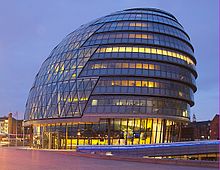
This article is part of a series on the
politics and government of
London British politics portal
British politics portalLocal government
The administration of London is formed of two tiers: a citywide, strategic tier and a local tier. Citywide administration is coordinated by the Greater London Authority (GLA), while local administration is carried out by 33 smaller authorities.[102] The GLA consists of two elected components: the Mayor of London, who has executive powers, and the London Assembly, which scrutinises the mayor's decisions and can accept or reject the mayor's budget proposals each year. The headquarters of the GLA is City Hall, Southwark; the mayor is Sadiq Khan, the first Muslim mayor of a major Western capital.[103][104] The mayor's statutory planning strategy is published as the London Plan, which was most recently revised in 2011.[105] The local authorities are the councils of the 32 London boroughs and the City of London Corporation.[106] They are responsible for most local services, such as local planning, schools, social services, local roads and refuse collection. Certain functions, such as waste management, are provided through joint arrangements. In 2009–2010 the combined revenue expenditure by London councils and the GLA amounted to just over £22 billion (£14.7 billion for the boroughs and £7.4 billion for the GLA).[107]
The London Fire Brigade is the statutory fire and rescue service for Greater London. It is run by the London Fire and Emergency Planning Authority and is the third largest fire service in the world.[108] National Health Service ambulance services are provided by the London Ambulance Service (LAS) NHS Trust, the largest free-at-the-point-of-use emergency ambulance service in the world.[109] The London Air Ambulance charity operates in conjunction with the LAS where required. Her Majesty's Coastguard and the Royal National Lifeboat Institution operate on the River Thames,[110][111] which is under the jurisdiction of the Port of London Authority from Teddington Lock to the sea.[112]
National government
London is the seat of the Government of the United Kingdom. Many government departments, as well as the Prime Minister's residence at 10 Downing Street, are based close to the Palace of Westminster, particularly along Whitehall.[113] The British Parliament is often referred to as the "Mother of Parliaments" (although this sobriquet was first applied to England itself by John Bright)[114] because it has been the model for most other parliamentary systems.[114] There are 73 Members of Parliament (MPs) from London, elected from local parliamentary constituencies in the national Parliament. As of May 2015, 45 are from the Labour Party, 27 are Conservatives, and one is a Liberal Democrat.[115]10 Downing Street, official residence of the Prime Minister
Policing and crime
Policing in Greater London, with the exception of the City of London, is provided by the Metropolitan Police Service, overseen by the Mayor through the Mayor's Office for Policing and Crime (MOPAC).[116][117] The City of London has its own police force – the City of London Police.[118] The British Transport Police are responsible for police services on National Rail, London Underground, Docklands Light Railway and Tramlink services.[119] A fourth police force in London, the Ministry of Defence Police, do not generally become involved with policing the general public.
Crime rates vary widely by area, ranging from parts with serious issues to parts considered very safe. Today crime figures are made available nationally at Local Authority[120] and Ward level.[121] In 2015 there were 118 homicides, a 25.5% increase over 2014.[122] The Metropolitan Police have made detailed crime figures, broken down by category at borough and ward level, available on their website since 2000.[123]
Geography
Scope
London, also referred to as Greater London, is one of nine regions of England and the top-level subdivision covering most of the city's metropolis.[note 5] The small ancient City of London at its core once comprised the whole settlement, but as its urban area grew, the Corporation of London resisted attempts to amalgamate the city with its suburbs, causing "London" to be defined in a number of ways for different purposes.[124]Satellite view of inner London
Forty per cent of Greater London is covered by the London post town, within which 'LONDON' forms part of postal addresses.[125][126] The London telephone area code (020) covers a larger area, similar in size to Greater London, although some outer districts are excluded and some places just outside are included. The Greater London boundary has been aligned to the M25 motorway in places.[127]
Outward urban expansion is now prevented by the Metropolitan Green Belt,[128] although the built-up area extends beyond the boundary in places, resulting in a separately defined Greater London Urban Area. Beyond this is the vast London commuter belt.[129] Greater London is split for some purposes into Inner London and Outer London.[130] The city is split by the River Thames into North and South, with an informal central London area in its interior. The coordinates of the nominal centre of London, traditionally considered to be the original Eleanor Cross at Charing Cross near the junction of Trafalgar Square and Whitehall, are about 51°30′26″N 00°07′39″W.[131] However the geographical centre of London, on one definition, is in the London Borough of Lambeth, just 0.1 miles to the northeast of Lambeth North tube station.[132]
Status
Within London, both the City of London and the City of Westminster have city status and both the City of London and the remainder of Greater London are counties for the purposes of lieutenancies.[133] The area of Greater London has incorporated areas that are part of the historic counties of Middlesex, Kent, Surrey, Essex and Hertfordshire.[134] London's status as the capital of England, and later the United Kingdom, has never been granted or confirmed officially—by statute or in written form.[note 6]
Its position was formed through constitutional convention, making its status as de facto capital a part of the UK's unwritten constitution. The capital of England was moved to London from Winchester as the Palace of Westminster developed in the 12th and 13th centuries to become the permanent location of the royal court, and thus the political capital of the nation.[138] More recently, Greater London has been defined as a region of England and in this context is known as London.[13]
Topography
London from Primrose HillGreater London encompasses a total area of 1,583 square kilometres (611 sq mi), an area which had a population of 7,172,036 in 2001 and a population density of 4,542 inhabitants per square kilometre (11,760/sq mi). The extended area known as the London Metropolitan Region or the London Metropolitan Agglomeration, comprises a total area of 8,382 square kilometres (3,236 sq mi) has a population of 13,709,000 and a population density of 1,510 inhabitants per square kilometre (3,900/sq mi).[139] Modern London stands on the Thames, its primary geographical feature, a navigable river which crosses the city from the south-west to the east. The Thames Valley is a floodplain surrounded by gently rolling hills including Parliament Hill, Addington Hills, and Primrose Hill. The Thames was once a much broader, shallower river with extensive marshlands; at high tide, its shores reached five times their present width.[140]London from Forest Hill
Since the Victorian era the Thames has been extensively embanked, and many of its London tributaries now flow underground. The Thames is a tidal river, and London is vulnerable to flooding.[141] The threat has increased over time because of a slow but continuous rise in high water level by the slow 'tilting' of Britain (up in the north and down in the south) caused by post-glacial rebound.[142]
In 1974, a decade of work began on the construction of the Thames Barrier across the Thames at Woolwich to deal with this threat. While the barrier is expected to function as designed until roughly 2070, concepts for its future enlargement or redesign are already being discussed.[143]
Climate
London in December 2013London has a temperate oceanic climate (Köppen: Cfb ), similar to all of southern England. Despite its reputation as being a rainy city, London receives less precipitation in a year than Rome, Bordeaux, Toulouse, Naples, Sydney and New York.[144][145][146][147][148][149] Temperature extremes for all sites in the London area range from 38.1 °C (100.6 °F) at Kew during August 2003[150] down to −16.1 °C (3.0 °F) at Northolt during January 1962.[151]Average summertime day temperatures range between 20 and 26 °C (68 and 79 °F). Although uncommon, temperatures as high as 38 °C (100 °F) have been recorded.
Summers are mild, but generally warm. London's average July high is 24 °C (75.2 °F). On average London will see 31 days above 25 °C (77.0 °F) each year, and 4.2 days above 30.0 °C (86.0 °F) every year. During the 2003 European heat wave there were 14 consecutive days above 30 °C (86.0 °F) and 2 consecutive days where temperatures reached 38 °C (100.4 °F), leading to hundreds of heat related deaths.[152]
Winters are generally cool, cloudy and damp with little temperature variation. Snowfall occurs occasionally and can cause travel disruption when this happens. Snowfall is more common in outer London. Spring and autumn are mixed seasons and can be pleasant. As a large city, London has a considerable urban heat island effect,[153] making the centre of London at times 5 °C (9 °F) warmer than the suburbs and outskirts. The effect of this can be seen below when comparing London Heathrow, 15 miles west of London, with the London Weather Centre, in the city centre.[154]
[hide]Climate data for London Heathrow (1981–2010, extremes 1948–present) Month Jan Feb Mar Apr May Jun Jul Aug Sep Oct Nov Dec Year Record high °C (°F) 17.2
(63)19.8
(67.6)24.2
(75.6)29.4
(84.9)32.8
(91)35.6
(96.1)36.7
(98.1)38.1
(100.6)35.4
(95.7)29.9
(85.8)20.8
(69.4)17.4
(63.3)38.1
(100.6)Average high °C (°F) 8.1
(46.6)8.4
(47.1)11.3
(52.3)14.2
(57.6)17.9
(64.2)21.0
(69.8)23.5
(74.3)23.2
(73.8)19.9
(67.8)15.5
(59.9)11.1
(52)8.3
(46.9)15.2
(59.36)Average low °C (°F) 2.3
(36.1)2.1
(35.8)3.9
(39)5.5
(41.9)8.7
(47.7)11.7
(53.1)13.9
(57)13.7
(56.7)11.4
(52.5)8.4
(47.1)4.9
(40.8)2.7
(36.9)7.43
(45.38)Record low °C (°F) −13.2
(8.2)−9.6
(14.7)−5.1
(22.8)−2.6
(27.3)−0.9
(30.4)1.5
(34.7)5.6
(42.1)5.9
(42.6)1.8
(35.2)−3.3
(26.1)−7.0
(19.4)−11.8
(10.8)−13.2
(8.2)Average precipitation mm (inches) 55.2
(2.173)40.9
(1.61)41.6
(1.638)43.7
(1.72)49.4
(1.945)45.1
(1.776)44.5
(1.752)49.5
(1.949)49.1
(1.933)68.5
(2.697)59.0
(2.323)55.2
(2.173)601.7
(23.689)Average precipitation days (≥ 1.0 mm) 11.1 8.5 9.3 9.1 8.8 8.2 7.7 7.5 8.1 10.8 10.3 10.2 109.6 Mean monthly sunshine hours 61.5 77.9 114.6 168.7 198.5 204.3 212.0 204.7 149.3 116.5 72.6 52.0 1,632.6 Source: Met Office [155] Royal Netherlands Meteorological Institute [156] [hide]Climate data for London Weather Centre, 2001-2014 Month Jan Feb Mar Apr May Jun Jul Aug Sep Oct Nov Dec Year Average high °C (°F) 8.5
(47.3)8.9
(48)11.7
(53.1)15.7
(60.3)18.6
(65.5)22.4
(72.3)23.6
(74.5)23.2
(73.8)20.8
(69.4)16.1
(61)11.9
(53.4)8.6
(47.5)15.83
(60.51)Daily mean °C (°F) 6.8
(44.2)6.8
(44.2)8.8
(47.8)12.0
(53.6)14.8
(58.6)18.3
(64.9)19.6
(67.3)19.4
(66.9)17.3
(63.1)13.5
(56.3)10.0
(50)7.0
(44.6)12.86
(55.13)Average low °C (°F) 5.0
(41)4.7
(40.5)5.8
(42.4)8.2
(46.8)10.9
(51.6)14.1
(57.4)15.5
(59.9)15.5
(59.9)13.7
(56.7)10.9
(51.6)8.0
(46.4)5.4
(41.7)9.81
(49.66)Source #1: Weather Online [157] Source #2: Tutiempo [158] Districts
London's vast urban area is often described using a set of district names, such as Bloomsbury, Mayfair, Wembley and Whitechapel. These are either informal designations, reflect the names of villages that have been absorbed by sprawl, or are superseded administrative units such as parishes or former boroughs.
Such names have remained in use through tradition, each referring to a local area with its own distinctive character, but without official boundaries. Since 1965 Greater London has been divided into 32 London boroughs in addition to the ancient City of London.[159][160] The City of London is the main financial district,[161] and Canary Wharf has recently developed into a new financial and commercial hub in the Docklands to the east.
The West End is London's main entertainment and shopping district, attracting tourists.[162] West London includes expensive residential areas where properties can sell for tens of millions of pounds.[163] The average price for properties in Kensington and Chelsea is over £2 million with a similarly high outlay in most of central London.[164][165]
The East End is the area closest to the original Port of London, known for its high immigrant population, as well as for being one of the poorest areas in London.[166] The surrounding East London area saw much of London's early industrial development; now, brownfield sites throughout the area are being redeveloped as part of the Thames Gateway including the London Riverside and Lower Lea Valley, which was developed into the Olympic Park for the 2012 Olympics and Paralympics.[166]
Architecture
London's buildings are too diverse to be characterised by any particular architectural style, partly because of their varying ages. Many grand houses and public buildings, such as the National Gallery, are constructed from Portland stone. Some areas of the city, particularly those just west of the centre, are characterised by white stucco or whitewashed buildings. Few structures in central London pre-date the Great Fire of 1666, these being a few trace Roman remains, the Tower of London and a few scattered Tudor survivors in the City. Further out is, for example, the Tudor-period Hampton Court Palace, England's oldest surviving Tudor palace, built by Cardinal Thomas Wolsey c.1515.[167]The Tower, with Tower Bridge built 800 years later on the River Thames
Wren's late 17th-century churches and the financial institutions of the 18th and 19th centuries such as the Royal Exchange and the Bank of England, to the early 20th century Old Bailey and the 1960s Barbican Estate form part of the varied architectural heritage.
30 St Mary Axe, also known as "the Gherkin", towers over St Andrew Undershaft. Modern architecture juxtaposed by historic architecture is seen often in LondonThe disused - but soon to be rejuvenated - 1939 Battersea Power Station by the river in the south-west is a local landmark, while some railway termini are excellent examples of Victorian architecture, most notably St. Pancras and Paddington.[168] The density of London varies, with high employment density in the central area, high residential densities in inner London, and lower densities in Outer London.Trafalgar Square and its fountains, with Nelson's Column on the right
The Monument in the City of London provides views of the surrounding area while commemorating the Great Fire of London, which originated nearby. Marble Arch and Wellington Arch, at the north and south ends of Park Lane, respectively, have royal connections, as do the Albert Memorial and Royal Albert Hall in Kensington. Nelson's Column is a nationally recognised monument in Trafalgar Square, one of the focal points of central London. Older buildings are mainly brick built, most commonly the yellow London stock brick or a warm orange-red variety, often decorated with carvings and white plaster mouldings.[169]
In the dense areas, most of the concentration is via medium- and high-rise buildings. London's skyscrapers, such as 30 St Mary Axe, Tower 42, the Broadgate Tower and One Canada Square, are mostly in the two financial districts, the City of London and Canary Wharf. High-rise development is restricted at certain sites if it would obstruct protected views of St Paul's Cathedral and other historic buildings. Nevertheless, there are a number of very tall skyscrapers in central London (see Tall buildings in London), including the 95-storey Shard London Bridge, the tallest building in the European Union.
Other notable modern buildings include City Hall in Southwark with its distinctive oval shape[170] and the British Library in Somers Town/Kings Cross. What was formerly the Millennium Dome, by the Thames to the east of Canary Wharf, is now an entertainment venue called the O2 Arena.
Natural history
The London Natural History Society suggest that London is "one of the World's Greenest Cities" with more than 40 percent green space or open water. They indicate that 2000 species of flowering plant have been found growing there and that the tidal Thames supports 120 species of fish.[171] They also state that over 60 species of bird nest in central London and that their members have recorded 47 species of butterfly, 1173 moths and more than 270 kinds of spider around London. London's wetland areas support nationally important populations of many water birds. London has 38 Sites of Special Scientific Interest (SSSIs), two National Nature Reserves and 76 Local Nature Reserves.[172]
Amphibians are common in the capital, including smooth newts living by the Tate Modern, and common frogs, common toads, palmate newts and great crested newts. On the other hand, native reptiles such as slow-worms, common lizards, grass snakes and adders, are mostly only seen in Outer London.[173]
Among other inhabitants of London are 10,000 foxes, so that there are now 16 foxes for every square mile (2.6 square kilometres) of London. These urban foxes are noticeably bolder than their country cousins, sharing the pavement with pedestrians and raising cubs in people's backyards. Foxes have even sneaked into the Houses of Parliament, where one was found asleep on a filing cabinet. Another broke into the grounds of Buckingham Palace, reportedly killing some of Queen Elizabeth II's prized pink flamingos. Generally, however, foxes and city folk appear to get along. A survey in 2001 by the London-based Mammal Society found that 80 percent of 3,779 respondents who volunteered to keep a diary of garden mammal visits liked having them around. This sample cannot be taken to represent Londoners as a whole.[174][175]Fox on Ayres Street, Southwark, South London
Other mammals found in Greater London are hedgehogs, rats, mice, rabbit, shrew, vole, and squirrels,[176] In wilder areas of Outer London, such as Epping Forest, a wide variety of mammals are found including hare, badger, field, bank and water vole, wood mouse, yellow-necked mouse, mole, shrew, and weasel, in addition to fox, squirrel and hedgehog. A dead otter was found at The Highway, in Wapping, about a mile from the Tower Bridge, which would suggest that they have begun to move back after being absent a hundred years from the city.[177] Ten of England's eighteen species of bats have been recorded in Epping Forest: soprano, nathusius and common pipistrelles, noctule, serotine, barbastelle, daubenton's, brown Long-eared, natterer's and leisler's.[178]
Among the strange sights seen in London have been a whale in the Thames,[179] while the BBC Two programme "Natural World: Unnatural History of London" shows pigeons using the London Underground to get around the city, a seal that takes fish from fishmongers outside Billingsgate Fish Market, and foxes that will "sit" if given sausages.[180]
Herds of red and fallow deer also roam freely within much of Richmond and Bushy Park. A cull takes place each November and February to ensure numbers can be sustained.[181] Epping Forest is also known for its fallow deer, which can frequently be seen in herds to the north of the Forest. A rare population of melanistic, black fallow deer is also maintained at the Deer Sanctuary near Theydon Bois. Muntjac deer, which escaped from deer parks at the turn of the twentieth century, are also found in the forest. While Londoners are accustomed to wildlife such as birds and foxes sharing the city, more recently urban deer have started becoming a regular feature, and whole herds of fallow and white-tailed deer come into residential areas at night to take advantage of London's green spaces.[182][183]
Demography
2011 United Kingdom Census[184] Country of birth Population  United Kingdom
United Kingdom5,175,677  India
India262,247  Poland
Poland158,300  Ireland
Ireland129,807  Nigeria
Nigeria114,718  Pakistan
Pakistan112,457  Bangladesh
Bangladesh109,948  Jamaica
Jamaica87,467  Sri Lanka
Sri Lanka84,542  France
France66,654 The 2011 census recorded that 2,998,264 people or 36.7% of London's population are foreign-born making London the city with the second largest immigrant population, behind New York City, in terms of absolute numbers. The table to the right shows the most common countries of birth of London residents. Note that some of the German-born population, in 18th position, are British citizens from birth born to parents serving in the British Armed Forces in Germany.[185] With increasing industrialisation, London's population grew rapidly throughout the 19th and early 20th centuries, and it was for some time in the late 19th and early 20th centuries the most populous city in the world. Its population peaked at 8,615,245 in 1939 immediately before the outbreak of the Second World War, but had declined to 7,192,091 at the 2001 Census. However, the population then grew by just over a million between the 2001 and 2011 Censuses, to reach 8,173,941 in the latter enumeration.[186]
However, London's continuous urban area extends beyond the borders of Greater London and was home to 9,787,426 people in 2011,[45] while its wider metropolitan area has a population of between 12 and 14 million depending on the definition used.[187][188] According to Eurostat, London is the most populous city and metropolitan area of the European Union and the second most populous in Europe. During the period 1991–2001 a net 726,000 immigrants arrived in London.[189]
The region covers an area of 1,579 square kilometres (610 sq mi). The population density is 5,177 inhabitants per square kilometre (13,410/sq mi),[190] more than ten times that of any other British region.[191] In terms of population, London is the 19th largest city and the 18th largest metropolitan region in the world. As of 2014, London has the largest number of billionaires (British Pound Sterling) in the world, with 72 residing in the city.[192] London ranks as one of the most expensive cities in the world, alongside Tokyo and Moscow.[193]
Ethnic groups
According to the Office for National Statistics, based on the 2011 Census estimates, 59.8 per cent of the 8,173,941 inhabitants of London were White, with 44.9 per cent White British, 2.2 per cent White Irish, 0.1 per cent gypsy/Irish traveller and 12.1 per cent classified as Other White.Ethnic groups in the 2011 census [194]
White (59.8%)Asian (18.4%)Black (13.3%)Mixed (5%)Arab (1.3%)Other (2.1%)
20.9 per cent of Londoners are of Asian and mixed-Asian descent. 19.7 per cent are of full Asian descent, with those of mixed-Asian heritage comprising 1.2 of the population. Indians account for 6.6 per cent of the population, followed by Pakistanis and Bangladeshis at 2.7 per cent each. Chinese peoples account for 1.5 per cent of the population, with Arabs comprising 1.3 per cent. A further 4.9 per cent are classified as "Other Asian".
15.6 per cent of London's population are of Black and mixed-Black descent. 13.3 per cent are of full Black descent, with those of mixed-Black heritage comprising 2.3 per cent. Black Africans account for 7.0 per cent of London's population, with 4.2 per cent as Black Caribbean and 2.1 per cent as "Other Black". 5.0 per cent are of mixed race.
Across London, Black and Asian children outnumber White British children by about six to four in state schools.[195] Altogether at the 2011 census, of London's 1,624,768 population aged 0 to 15, 46.4 per cent were White, 19.8 per cent were Asian, 19 per cent were Black, 10.8 per cent were Mixed and 4 per cent represented another ethnic group.[196] In January 2005, a survey of London's ethnic and religious diversity claimed that there were more than 300 languages spoken in London and more than 50 non-indigenous communities with a population of more than 10,000.[197] Figures from the Office for National Statistics show that, in 2010, London's foreign-born population was 2,650,000 (33 per cent), up from 1,630,000 in 1997.
The 2011 census showed that 36.7 per cent of Greater London's population were born outside the UK.[198] A portion of the German-born population are likely to be British nationals born to parents serving in the British Armed Forces in Germany.[199] Estimates produced by the Office for National Statistics indicate that the five largest foreign-born groups living in London in the period July 2009 to June 2010 were those born in India, Poland, the Republic of Ireland, Bangladesh and Nigeria.[200]
Religion
According to the 2011 Census, the largest religious groupings are Christians (48.4 per cent), followed by those of no religion (20.7 per cent), Muslims (12.4 per cent), no response (8.5 per cent), Hindus (5.0 per cent), Jews (1.8 per cent), Sikhs (1.5 per cent), Buddhists (1.0 per cent) and other (0.6 per cent).
London has traditionally been Christian, and has a large number of churches, particularly in the City of London. The well-known St Paul's Cathedral in the City and Southwark Cathedral south of the river are Anglican administrative centres,[202] while the Archbishop of Canterbury, principal bishop of the Church of England and worldwide Anglican Communion, has his main residence at Lambeth Palace in the London Borough of Lambeth.[203]
Important national and royal ceremonies are shared between St Paul's and Westminster Abbey.[204] The Abbey is not to be confused with nearby Westminster Cathedral, which is the largest Roman Catholic cathedral in England and Wales.[205] Despite the prevalence of Anglican churches, observance is very low within the Anglican denomination. Church attendance continues on a long, slow, steady decline, according to Church of England statistics.[206]
London is also home to sizeable Muslim, Hindu, Sikh, and Jewish communities. Notable mosques include the East London Mosque in Tower Hamlets, London Central Mosque on the edge of Regent's Park[207] and the Baitul Futuh Mosque of the Ahmadiyya Muslim Community. Following the oil boom, increasing numbers of wealthy Hindus and Middle-Eastern Muslims have based themselves around Mayfair and Knightsbridge in West London.[208][209][210] There are large Muslim communities in the eastern boroughs of Tower Hamlets and Newham.[211] Large Hindu communities are in the north-western boroughs of Harrow and Brent, the latter of which is home to Europe's largest Hindu temple, Neasden Temple.[212] London is also home to 42 Hindu temples. There are Sikh communities in East and West London, particularly in Southall, home to one of the largest Sikh populations and the largest Sikh temple outside India.[213]
The majority of British Jews live in London, with significant Jewish communities in Stamford Hill, Stanmore, Golders Green, Finchley, Hampstead, Hendon and Edgware in North London. Bevis Marks Synagogue in the City of London is affiliated to London's historic Sephardic Jewish community. It is the only synagogue in Europe which has held regular services continuously for over 300 years. Stanmore and Canons Park Synagogue has the largest membership of any single Orthodox synagogue in the whole of Europe, overtaking Ilford synagogue (also in London) in 1998.[214] The community set up the London Jewish Forum in 2006 in response to the growing significance of devolved London Government.[215]
Accent
There are many accents that are traditionally thought of as London accents. The most well known of the London accents long ago acquired the Cockney label, which is heard both in London itself, and across the wider South East England region more generally.[216] The accent of a 21st-century Londoner varies widely; what is becoming more and more common amongst the under-30s however is some fusion of Cockney with a whole array of ethnic accents, in particular Caribbean, which form an accent labelled Multicultural London English (MLE).[217] The other widely heard and spoken accent is RP (Received Pronunciation) in various forms, which can often be heard in the media and many of other traditional professions and beyond, although this accent is not limited to London and South East England, and can also be heard selectively throughout the whole UK amongst certain social groupings.
Economy
London generates about 20 per cent of the UK's GDP[219] (or $600 billion in 2014); while the economy of the London metropolitan area—the largest in Europe—generates about 30 per cent of the UK's GDP (or an estimated $669 billion in 2005).[220] London has five major business districts: the City, Westminster, Canary Wharf, Camden & Islington and Lambeth & Southwark. One way to get an idea of their relative importance is to look at relative amounts of office space: Greater London had 27 million m2 of office space in 2001, and the City contains the most space, with 8 million m2 of office space. London has some of the highest real estate prices in the world.[221][222] London is the world's most expensive office market for the last three years according to world property journal (2015) report.[223] As of 2015 the residential property in London is worth $2.2 trillion – same value as that of Brazil annual GDP.[224] The city has the highest property prices of any European city according to the Office for National Statistics and the European Office of Statistics.[225] On average the price per square metre in central London is €24,252 (April 2014). This is higher than the property prices in other G8 European capital cities; Berlin €3,306, Rome €6,188 and Paris €11,229.[226]The City of London, one of the largest financial centres in the world[218]
The City of London
London finance industry is based in the City of London and Canary Wharf, the two major Central Business Districts in London. London is one of the pre-eminent financial centres of the world as the most important location for international finance.[227][228] London took over as a major financial centre shortly after 1795 when the Dutch Republic collapsed before the Napoleonic armies. For many bankers established in Amsterdam (e.g. Hope, Baring), this was only time to move to London. The London financial elite was strengthened by a strong Jewish community from all over Europe capable of mastering the most sophisticated financial tools of the time.[229] This unique concentration of talents accelerated the transition from the Commercial Revolution to the Industrial Revolution. By the end of the 19th century, Britain was the wealthiest of all nations, and London a leading financial centre. Still, as of 2016 London tops the world rankings on both the Global Financial Centres Index (GFCI)[230] and The Global Cities Index.[231]Aerial view of the City of London
London's largest industry is finance, and its financial exports make it a large contributor to the UK's balance of payments. Around 325,000 people were employed in financial services in London until mid-2007. London has over 480 overseas banks, more than any other city in the world. It is also the world's biggest currency trading centre, accounting for some 37 percent of the $5.1 trillion average daily volume, according to the BIS.[232] Over 85 percent (3.2 million) of the employed population of greater London works in the services industries. Because of its prominent global role, London's economy had been affected by the financial crisis of 2007–2008. However, by 2010 the City has recovered; put in place new regulatory powers, proceeded to regain lost ground and re-established London's economic dominance.[233] Along with professional services headquarters, the City of London is home to the Bank of England, London Stock Exchange, and Lloyd's of London insurance market.
Over half of the UK's top 100 listed companies (the FTSE 100) and over 100 of Europe's 500 largest companies have their headquarters in central London. Over 70 per cent of the FTSE 100 are within London's metropolitan area, and 75 per cent of Fortune 500 companies have offices in London.[234]
Media and technology
Media companies are concentrated in London and the media distribution industry is London's second most competitive sector.[235] The BBC is a significant employer, while other broadcasters also have headquarters around the City. Many national newspapers are edited in London. London is a major retail centre and in 2010 had the highest non-food retail sales of any city in the world, with a total spend of around £64.2 billion.[236] The Port of London is the second-largest in the United Kingdom, handling 45 million tonnes of cargo each year.[237]
A growing number of technology companies are based in London notably in East London Tech City, also known as Silicon Roundabout. In April 2014, the city was among the first to receive a geoTLD.[238] In February 2014 London was ranked as the European City of the Future [239] in the 2014/15 list by FDi Magazine.[240]
The gas and electricity distribution networks that manage and operate the towers, cables and pressure systems that deliver energy to consumers across the city are managed by National Grid plc, SGN[241] and UK Power Networks.[242]
Tourism
London is one of the leading tourist destinations in the world and in 2015 was ranked as the most visited city in the world with over 65 million visits.[243][244] It is also the top city in the world by visitor cross-border spending, estimated at US$20.23 billion in 2015.[245] Tourism is one of London's prime industries, employing the equivalent of 350,000 full-time workers in 2003,[246] and the city accounts for 54% of all inbound visitor spending in the UK.[247] As of 2016 London is the world top city destination as ranked by TripAdvisor users.[248]
In 2015, the top most-visited attractions in UK were all in London. The top 10 most visited attractions were: (with visits per venue) [249]
- The British Museum: 6,820,686
- The National Gallery: 5,908,254
- Natural History Museum (South Kensington): 5,284,023
- Southbank Centre: 5,102,883
- Tate Modern: 4,712,581
- Victoria and Albert Museum (South Kensington): 3,432,325
- Science Museum: 3,356,212
- Somerset House: 3,235,104
- Tower of London: 2,785,249
- National Portrait Gallery: 2,145,486
Housing crisis
Thousands of homeless families find themselves in emergency accommodation for at least two years.[251] A growth in the number of UK households has led to the homeless charity Shelter stating: "This growth is a result of people living longer, more people living alone or in smaller households, and net migration."[252]
Transport
Transport is one of the four main areas of policy administered by the Mayor of London,[253] however the mayor's financial control does not extend to the longer distance rail network that enters London. In 2007 he assumed responsibility for some local lines, which now form the London Overground network, adding to the existing responsibility for the London Underground, trams and buses. The public transport network is administered by Transport for London (TFL).A black London taxi, also known as a hackney carriage
The lines that formed the London Underground, as well as trams and buses, became part of an integrated transport system in 1933 when the London Passenger Transport Board or London Transport was created. Transport for London is now the statutory corporation responsible for most aspects of the transport system in Greater London, and is run by a board and a commissioner appointed by the Mayor of London.[254]
Aviation
London is a major international air transport hub with the busiest city airspace in the world. Eight airports use the word London in their name, but most traffic passes through six of these. Additionally, various other airports also serve London, catering primarily to general aviation flights.London Heathrow Airport is the busiest airport in Europe as well as the second busiest in the world for international passenger traffic. (Terminal 5C is pictured)
- London Heathrow Airport, in Hillingdon, West London, is the busiest airport in the world for international traffic, and is the major hub of the nation's flag carrier, British Airways.[255] In March 2008 its fifth terminal was opened.[256] There were plans for a third runway and a sixth terminal; however, these were cancelled by the Coalition Government on 12 May 2010.[257]
- Gatwick Airport, south of London in West Sussex, handles similar traffic, with some cheap short-haul flights.[258]
- Stansted Airport, north east of London in Essex, is a local UK hub.
- Luton Airport to the north of London in Bedfordshire, caters mostly for cheap short-haul flights.[259][260]
- London City Airport, the smallest and most central airport, in Newham, East London, is focused on business travellers, with a mixture of full service short-haul scheduled flights and considerable business jet traffic.[261]
- London Southend Airport, east of London in Essex, is a smaller, regional airport that mainly caters for cheap short-haul flights.
Rail
Underground and DLR
The London Underground, commonly referred to as the Tube, is the oldest[262] and second longest[263] metro system in the world. The system serves 270 stations[264] and was formed from several private companies, including the world's first underground electric line, the City and South London Railway.[265] It dates from 1863.[266]The London Underground is the world's oldest and second-longest rapid transit system
Over four million journeys are made every day on the Underground network, over 1 billion each year.[267] An investment programme is attempting to reduce congestion and improve reliability, including £6.5 billion (€7.7 billion) spent before the 2012 Summer Olympics.[268] The Docklands Light Railway (DLR), which opened in 1987, is a second, more local metro system using smaller and lighter tram-type vehicles that serve the Docklands, Greenwich and Lewisham.
Suburban
There are 366 railway stations in the London Travelcard Zones on an extensive above-ground suburban railway network. South London, particularly, has a high concentration of railways as it has fewer Underground lines. Most rail lines terminate around the centre of London, running into eighteen terminal stations, with the exception of the Thameslink trains connecting Bedford in the north and Brighton in the south via Luton and Gatwick airports.[269] London has Britain's busiest station by number of passengers – Waterloo, with over 184 million people using the interchange station complex (which includes Waterloo East station) each year.[270][271] Clapham Junction is the busiest station in Europe by the number of trains passing.King's Cross railway station Western Concourse
With the need for more rail capacity in London, Crossrail is due to open in 2018. It will be a new railway line running east to west through London and into the Home Counties with a branch to Heathrow Airport.[272] It is Europe's biggest construction project, with a £15 billion projected cost.[273][274]
Inter-city and international
London is the centre of the National Rail network, with 70 percent of rail journeys starting or ending in London.[275] Like suburban rail services, regional and inter-city trains depart from several termini around the city centre, linking London with the rest of Britain including Birmingham, Brighton, Reading, Bristol, Cardiff, Derby, Exeter, Sheffield, Southampton, Leeds, Liverpool, Manchester, Cambridge, Newcastle-upon-Tyne, Edinburgh and Glasgow.St Pancras International is the main terminal for high speed Eurostar and HS1 services, as well as commuter suburban Thameslink and inter-city East Midlands Trains services
Some international railway services to Continental Europe were operated during the 20th century as boat trains, such as the Admiraal de Ruijter to Amsterdam and the Night Ferry to Paris and Brussels. The opening of the Channel Tunnel in 1994 connected London directly to the continental rail network, allowing Eurostar services to begin. Since 2007, high-speed trains link St. Pancras International with Lille, Paris, Brussels and European tourist destinations via the High Speed 1 rail link and the Channel Tunnel.[276] The first high-speed domestic trains started in June 2009 linking Kent to London.[277] There are plans for a second high speed line linking London to the Midlands, North West England, and Yorkshire.
Freight
Although rail freight levels are far down compared to their height, significant quantities of cargo are also carried into and out of London by rail; chiefly building materials and landfill waste.[278] As a major hub of the British railway network, London's tracks also carry large amounts of freight for the other regions, such as container freight from the Channel Tunnel and English Channel ports, and nuclear waste for reprocessing at Sellafield.[278]
Buses and trams
London's bus network is one of the largest in the world, running 24 hours a day, with about 8,500 buses, more than 700 bus routes and around 19,500 bus stops.[279] In 2013, the network had more than 2 billion commuter trips per annum, more than the Underground.[279] Around £850 million is taken in revenue each year. London has the largest wheelchair accessible network in the world[280] and, from the 3rd quarter of 2007, became more accessible to hearing and visually impaired passengers as audio-visual announcements were introduced. The distinctive red double-decker buses are an internationally recognised trademark of London transport along with black cabs and the Tube.[281][282]The red double decker bus is an iconic symbol of London
London has a modern tram network, known as Tramlink, centred on Croydon in South London. The network has 39 stops and four routes, and carried 28 million people in 2013.[283] Since June 2008 Transport for London has completely owned Tramlink, and it plans to spend £54m by 2015 on maintenance, renewals, upgrades and capacity enhancements.[284]
Cable car
London's first and only cable car, known as the Emirates Air Line, opened in June 2012. Crossing the River Thames, linking Greenwich Peninsula and the Royal Docks in the east of the city, the cable car is integrated with London's Oyster Card ticketing system, although special fares are charged. Costing £60 million to build, it carries over 3,500 passengers every day, although this is very much lower than its capacity. Similar to the Santander Cycles bike hire scheme, the cable car is sponsored in a 10-year deal by the airline Emirates.
Cycling
Cycling is an increasingly popular way to get around London. The launch of a cycle hire scheme in July 2010 has been successful and generally well received. The London Cycling Campaign lobbies for better provision.[285]Santander Cycle Hire near Victoria in Central London
Port and river boats
From being the largest port in the world, the Port of London is now only the second-largest in the United Kingdom, handling 45 million tonnes of cargo each year.[237] Most of this actually passes through the Port of Tilbury, outside the boundary of Greater London.
London has frequent river boat services on the Thames known as Thames Clippers. These run up to every 20 minutes between Embankment Pier and North Greenwich Pier. The Woolwich Ferry, with 2.5 million passengers every year,[286] is a frequent service linking the North and South Circular Roads. Other operators run both commuter and tourist boat services in London.
Roads
Although the majority of journeys involving central London are made by public transport, car travel is common in the suburbs. The inner ring road (around the city centre), the North and South Circular roads (in the suburbs), and the outer orbital motorway (the M25, outside the built-up area) encircle the city and are intersected by a number of busy radial routes—but very few motorways penetrate into inner London. A plan for a comprehensive network of motorways throughout the city (the Ringways Plan) was prepared in the 1960s but was mostly cancelled in the early 1970s. The M25 is the longest ring-road motorway in the world at 121.5 mi (195.5 km) long.[287][288] The A1 and M1 connect London to Leeds, and Newcastle and Edinburgh.The A102, near Greenwich. This was one of the few routes proposed in the Ringways Plan within Inner London to be built.
London is notorious for its traffic congestion, with the M25 motorway the busiest stretch in the country. The average speed of a car in the rush hour is 10.6 mph (17.1 km/h).[289]
In 2003, a congestion charge was introduced to reduce traffic volumes in the city centre. With a few exceptions, motorists are required to pay £10 per day to drive within a defined zone encompassing much of central London.[290][291] Motorists who are residents of the defined zone can buy a greatly reduced season pass.[292] London government initially expected the Congestion Charge Zone to increase daily peak period Underground and bus users by 20,000 people, reduce road traffic by 10 to 15 per cent, increase traffic speeds by 10 to 15 per cent, and reduce queues by 20 to 30 per cent.[293] Over the course of several years, the average number of cars entering the centre of London on a weekday was reduced from 195,000 to 125,000 cars – a 35-per-cent reduction of vehicles driven per day.[294]
Education
Tertiary education
King's College London, established by Royal Charter having been founded by King George IV and the Duke of Wellington in 1829, is one of the founding colleges of the University of LondonLondon is a major global centre of higher education teaching and research and has the largest concentration of higher education institutes in Europe.[40] According to the QS World University Rankings 2015/16, London has the greatest concentration of top class universities in the world[295][296] and its international student population of around 110,000 is larger than any other city in the world.[297] A 2014 PricewaterhouseCoopers report termed London as the global capital of higher education.[298]The Wilkins Building at University College London
A number of world-leading education institutions are based in London. In the 2014/15 QS World University Rankings, Imperial College London is ranked joint 2nd in the world, University College London (UCL) is ranked 5th, and King's College London (KCL) is ranked 16th.[299] The London School of Economics has been described as the world's leading social science institution for both teaching and research.[300] The London Business School is considered one of the world's leading business schools and in 2015 its MBA programme was ranked second best in the world by the Financial Times.[301]
With 120,000 students in London,[302] the federal University of London is the largest contact teaching university in the UK.[303] It includes five multi-faculty universities – City, King's College London, Queen Mary, Royal Holloway and UCL – and a number of smaller and more specialised institutions including Birkbeck, the Courtauld Institute of Art, Goldsmiths, Guildhall School of Music and Drama, the London Business School, the London School of Economics, the London School of Hygiene & Tropical Medicine, the Royal Academy of Music, the Central School of Speech and Drama, the Royal Veterinary College and the School of Oriental and African Studies.[304] Members of the University of London have their own admissions procedures, and some award their own degrees.
A number of universities in London are outside the University of London system, including Brunel University, Imperial College London, Kingston University, London Metropolitan University,[305] University of East London, University of West London, University of Westminster, London South Bank University, Middlesex University, and University of the Arts London (the largest university of art, design, fashion, communication and the performing arts in Europe).[306] In addition there are three international universities in London – Regent's University London, Richmond, The American International University in London and Schiller International University.
London is home to five major medical schools – Barts and The London School of Medicine and Dentistry (part of Queen Mary), King's College London School of Medicine (the largest medical school in Europe), Imperial College School of Medicine, UCL Medical School and St George's, University of London – and has a large number of affiliated teaching hospitals. It is also a major centre for biomedical research, and three of the UK's eight academic health science centres are based in the city – Imperial College Healthcare, King's Health Partners and UCL Partners (the largest such centre in Europe).[307]The front façade of the Royal College of Music
There are a number of business schools in London, including the London School of Business and Finance, Cass Business School (part of City University London), Hult International Business School, ESCP Europe, European Business School London, Imperial College Business School, the London Business School and the UCL School of Management. London is also home to many specialist arts education institutions, including the Academy of Live and Recorded Arts, Central School of Ballet, LAMDA, London College of Contemporary Arts (LCCA), London Contemporary Dance School, National Centre for Circus Arts, RADA, Rambert School of Ballet and Contemporary Dance, the Royal College of Art, the Royal College of Music and Trinity Laban.
Primary and secondary education
The majority of primary and secondary schools and further-education colleges in London are controlled by the London boroughs or otherwise state-funded; leading examples include City and Islington College, Ealing, Hammersmith and West London College, Leyton Sixth Form College, Tower Hamlets College, Bethnal Green Academy and Newham College. There are also a number of private schools and colleges in London, some old and famous, such as City of London School, Harrow, St Paul's School, Haberdashers' Aske's Boys' School, University College School, The John Lyon School, Highgate School and Westminster School.
Culture
Leisure and entertainment
Leisure is a major part of the London economy, with a 2003 report attributing a quarter of the entire UK leisure economy to London.[308] Globally, the city is amongst the big four fashion capitals of the world, and according to official statistics, London is the world's third busiest film production centre, presents more live comedy than any other city,[309] and has the biggest theatre audience of any city in the world.[310]
Within the City of Westminster in London, the entertainment district of the West End has its focus around Leicester Square, where London and world film premieres are held, and Piccadilly Circus, with its giant electronic advertisements.[311] London's theatre district is here, as are many cinemas, bars, clubs, and restaurants, including the city's Chinatown district (in Soho), and just to the east is Covent Garden, an area housing speciality shops. The city is the home of Andrew Lloyd Webber, whose musicals have dominated the West End theatre since the late 20th century.[312] The United Kingdom's Royal Ballet, English National Ballet, Royal Opera, and English National Opera are based in London and perform at the Royal Opera House, the London Coliseum, Sadler's Wells Theatre, and the Royal Albert Hall, as well as touring the country.[313]
Islington's 1 mile (1.6 km) long Upper Street, extending northwards from Angel, has more bars and restaurants than any other street in the United Kingdom.[314] Europe's busiest shopping area is Oxford Street, a shopping street nearly 1 mile (1.6 km) long, making it the longest shopping street in the UK. Oxford Street is home to vast numbers of retailers and department stores, including the world-famous Selfridges flagship store.[315] Knightsbridge, home to the equally renowned Harrods department store, lies to the south-west.
London is home to designers Vivienne Westwood, Galliano, Stella McCartney, Manolo Blahnik, and Jimmy Choo, among others; its renowned art and fashion schools make it an international centre of fashion alongside Paris, Milan, and New York. London offers a great variety of cuisine as a result of its ethnically diverse population. Gastronomic centres include the Bangladeshi restaurants of Brick Lane and the Chinese restaurants of Chinatown.[316]Shakespeare's Globe is a modern reconstruction of the Globe Theatre on the south bank of the River Thames
There is a variety of annual events, beginning with the relatively new New Year's Day Parade, a fireworks display at the London Eye; the world's second largest street party, the Notting Hill Carnival, is held on the late August Bank Holiday each year. Traditional parades include November's Lord Mayor's Show, a centuries-old event celebrating the annual appointment of a new Lord Mayor of the City of London with a procession along the streets of the City, and June's Trooping the Colour, a formal military pageant performed by regiments of the Commonwealth and British armies to celebrate the Queen's Official Birthday.[317]
Literature, film and television
London has been the setting for many works of literature. The literary centres of London have traditionally been hilly Hampstead and (since the early 20th century) Bloomsbury. Writers closely associated with the city are the diarist Samuel Pepys, noted for his eyewitness account of the Great Fire, Charles Dickens, whose representation of a foggy, snowy, grimy London of street sweepers and pickpockets has been a major influence on people's vision of early Victorian London, and Virginia Woolf, regarded as one of the foremost modernist literary figures of the 20th century.[318]Keats House, where Keats wrote his Ode to a Nightingale. The village of Hampstead has historically been a literary centre in London.
The pilgrims in Geoffrey Chaucer's late 14th-century Canterbury Tales set out for Canterbury from London – specifically, from the Tabard inn, Southwark. William Shakespeare spent a large part of his life living and working in London; his contemporary Ben Jonson was also based there, and some of his work—most notably his play The Alchemist—was set in the city.[318] A Journal of the Plague Year (1722) by Daniel Defoe is a fictionalisation of the events of the 1665 Great Plague.[318] Later important depictions of London from the 19th and early 20th centuries are Dickens' novels, and Arthur Conan Doyle's Sherlock Holmes stories.[318] Modern writers pervasively influenced by the city include Peter Ackroyd, author of a "biography" of London, and Iain Sinclair, who writes in the genre of psychogeography.Sherlock Holmes Museum in Baker Street, bearing the number 221B
London has played a significant role in the film industry. Major studios within or bordering London include Twickenham, Ealing, Shepperton, Pinewood, Elstree and Borehamwood,[319] and a special effects and post-production community centred in Soho. Working Title Films has its headquarters in London.[320] London has been the setting for films including Oliver Twist (1948), Scrooge (1951), Peter Pan (1953), The 101 Dalmatians (1961), My Fair Lady (1964), Mary Poppins (1964), Blowup (1966), The Long Good Friday (1980), Notting Hill (1999), Love Actually (2003), V For Vendetta (2005), Sweeney Todd: The Demon Barber Of Fleet Street (2008) and The King's Speech (2010). Notable actors and filmmakers from London include; Charlie Chaplin, Alfred Hitchcock, Michael Caine, Helen Mirren, Gary Oldman, Christopher Nolan, Jude Law, Benedict Cumberbatch, Tom Hardy, Keira Knightley and Daniel Day-Lewis. As of 2008, the British Academy Film Awards have taken place at the Royal Opera House. London is a major centre for television production, with studios including BBC Television Centre, The Fountain Studios and The London Studios. Many television programmes have been set in London, including the popular television soap opera EastEnders, broadcast by the BBC since 1985.
Museums and art galleries
London is home to many museums, galleries, and other institutions, many of which are free of admission charges and are major tourist attractions as well as playing a research role. The first of these to be established was the British Museum in Bloomsbury, in 1753. Originally containing antiquities, natural history specimens, and the national library, the museum now has 7 million artefacts from around the globe. In 1824, the National Gallery was founded to house the British national collection of Western paintings; this now occupies a prominent position in Trafalgar Square.The British Museum
In the latter half of the 19th century the locale of South Kensington was developed as "Albertopolis", a cultural and scientific quarter. Three major national museums are there: the Victoria and Albert Museum (for the applied arts), the Natural History Museum, and the Science Museum. The National Portrait Gallery was founded in 1856 to house depictions of figures from British history; its holdings now comprise the world's most extensive collection of portraits.[321] The national gallery of British art is at Tate Britain, originally established as an annexe of the National Gallery in 1897. The Tate Gallery, as it was formerly known, also became a major centre for modern art; in 2000, this collection moved to Tate Modern, a new gallery housed in the former Bankside Power Station.
Music
London is one of the major classical and popular music capitals of the world and is home to major music corporations, such as Warner Music Group, as well as countless bands, musicians and industry professionals. The city is also home to many orchestras and concert halls, such as the Barbican Arts Centre (principal base of the London Symphony Orchestra and the London Symphony Chorus), Cadogan Hall (Royal Philharmonic Orchestra) and the Royal Albert Hall (The Proms).[313] London's two main opera houses are the Royal Opera House and the London Coliseum.[313] The UK's largest pipe organ is at the Royal Albert Hall. Other significant instruments are at the cathedrals and major churches. Several conservatoires are within the city: Royal Academy of Music, Royal College of Music, Guildhall School of Music and Drama and Trinity Laban.The Royal Albert Hall hosts concerts and musical events
London has numerous venues for rock and pop concerts, including the world's busiest arena the O2 arena[322] and other large arenas such as Earls Court, Wembley Arena, as well as many mid-sized venues, such as Brixton Academy, the Hammersmith Apollo and the Shepherd's Bush Empire.[313] Several music festivals, including the Wireless Festival, South West Four, Lovebox, and Hyde Park's British Summer Time are all held in London.[323] The city is home to the original Hard Rock Cafe and the Abbey Road Studios, where The Beatles recorded many of their hits. In the 1960s, 1970s and 1980s, musicians and groups like Elton John, Pink Floyd, Cliff Richard, David Bowie, Queen, The Kinks, The Rolling Stones, The Who, Eric Clapton, Led Zeppelin, The Small Faces, Iron Maiden, Fleetwood Mac, Elvis Costello, Cat Stevens, The Police, The Cure, Madness, The Jam, Ultravox, Spandau Ballet, Culture Club, Dusty Springfield, Phil Collins, Rod Stewart, Adam Ant, Status Quo and Sade, derived their sound from the streets and rhythms of London.[324]
London was instrumental in the development of punk music,[325] with figures such as the Sex Pistols, The Clash,[324] and Vivienne Westwood all based in the city. More recent artists to emerge from the London music scene include George Michael's Wham!, Kate Bush, Seal, the Pet Shop Boys, Bananarama, Siouxsie and the Banshees, Bush, the Spice Girls, Jamiroquai, Blur, McFly, The Prodigy, Gorillaz, Bloc Party, Mumford & Sons, Coldplay, Amy Winehouse, Adele, Sam Smith, Ed Sheeran, Paloma Faith, Ellie Goulding, One Direction and Florence and the Machine.[326][327][328] London is also a centre for urban music. In particular the genres UK garage, drum and bass, dubstep and grime evolved in the city from the foreign genres of hip hop and reggae, alongside local drum and bass. Black music station BBC Radio 1Xtra was set up to support the rise of home-grown urban music both in London and in the rest of the UK.
Notable people
Recreation
Parks and open spaces
The largest parks in the central area of London are three of the eight Royal Parks, namely Hyde Park and its neighbour Kensington Gardens in the west, and Regent's Park to the north.[329] Hyde Park in particular is popular for sports and sometimes hosts open-air concerts. Regent's Park contains London Zoo, the world's oldest scientific zoo, and is near the tourist attraction of Madame Tussauds Wax Museum.[330][331] Primrose Hill, immediately to the north of Regent's Park, at 256 feet (78 m)[332] is a popular spot from which to view the city skyline.Aerial view of Hyde ParkSt. James's Park lake with the London Eye in the distance
Close to Hyde Park are smaller Royal Parks, Green Park and St. James's Park.[333] A number of large parks lie outside the city centre, including Hampstead Heath and the remaining Royal Parks of Greenwich Park to the south-east[334] and Bushy Park and Richmond Park (the largest) to the south-west,[335][336] Hampton Court Park is also a royal park, but, because it contains a palace, it is administered by the Historic Royal Palaces, unlike the eight Royal Parks.[337]
Close to Richmond Park is Kew Gardens which has the world's largest collection of living plants. In 2003, the gardens were put on the UNESCO list of World Heritage Sites.[338] There are also numerous parks administered by London's borough Councils, including Victoria Park in the East End and Battersea Park in the centre. Some more informal, semi-natural open spaces also exist, including the 320-hectare (790-acre) Hampstead Heath of North London,[339] and Epping Forest, which covers 2,476 hectares (6,118 acres)[340] in the east. Both are controlled by the City of London Corporation.[341][342] Hampstead Heath incorporates Kenwood House, a former stately home and a popular location in the summer months when classical musical concerts are held by the lake, attracting thousands of people every weekend to enjoy the music, scenery and fireworks.[343]
Epping Forest is a popular venue for various outdoor activities, including mountain biking, walking, horse riding, golf, angling, and orienteering.[344]
Walking
Walking is a popular recreational activity in London. Areas that provide for walks






